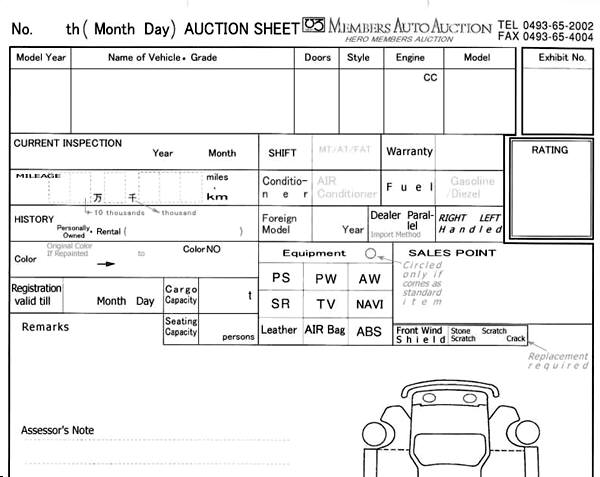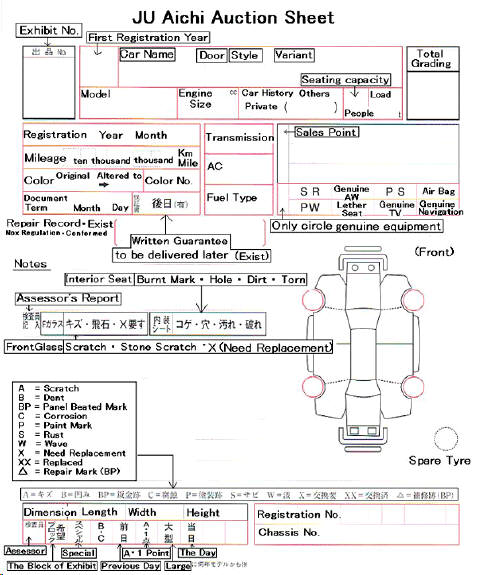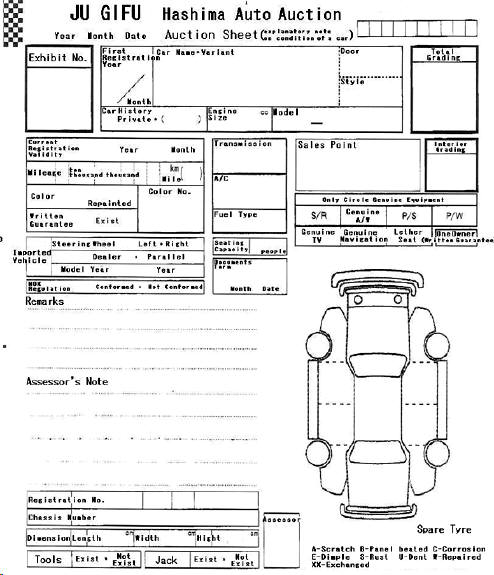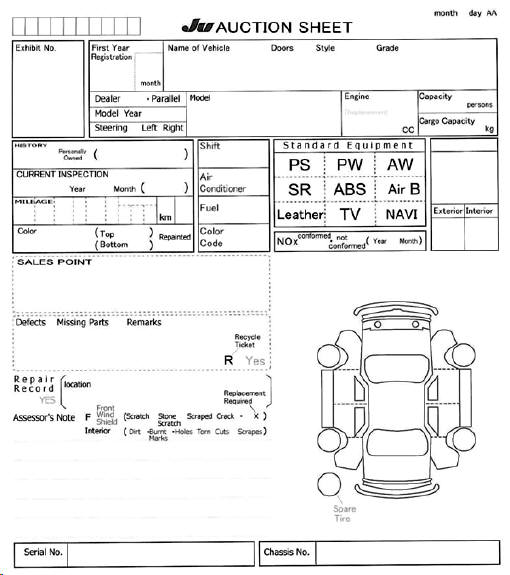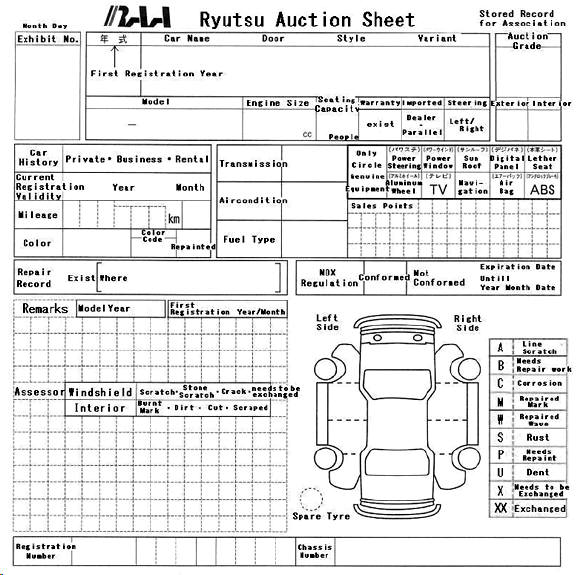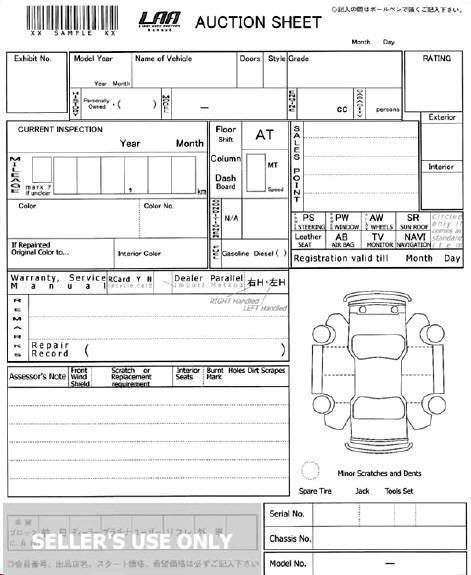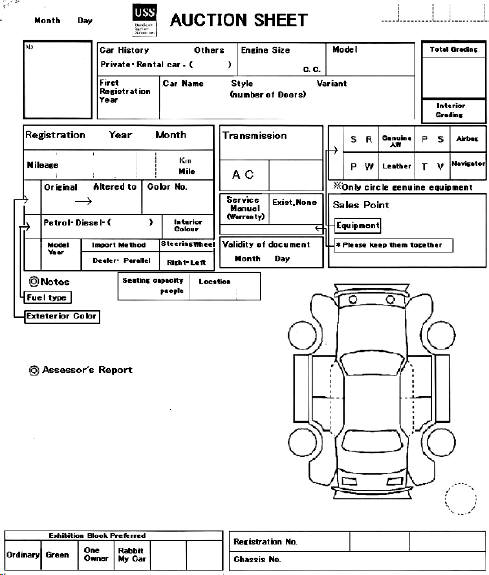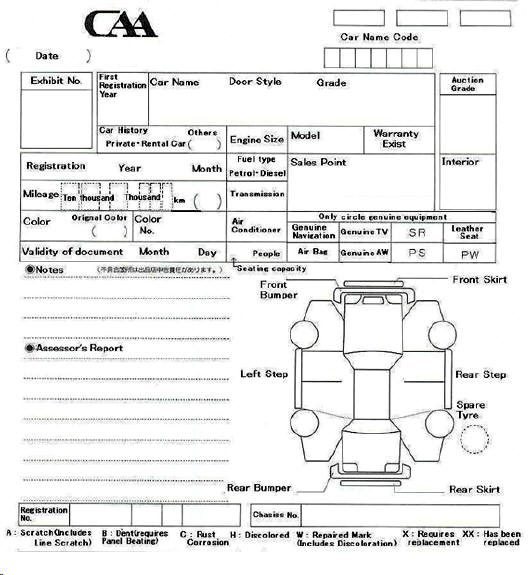Car sourcing by us
Using our service, you can source rare cars, and exceptional examples of cars available.
In today’s market, it is not necessarily the cheapest option as locally sourced cars and past imports are often cheaper, but freshly imported cars have not been subjected to substandard roads or bad weather conditions and will generally will be in much better condition, and have less mileage and a better standard of maintenance.
If you have a specific requirement for a used car, we can use our trade contacts to find the exact car you are looking for, right down to a specific color and specification if necessary.
We will ensure that the car is an excellent example, and because we are buying it ‘to order’ (ie. we have no stocking costs and are buying at today’s money) , we can offer an extremely competitive price, thereby saving you money, usually thousands over buying from a main dealer.
Understanding the Japanese Auction Sheet
When viewing cars at auction you may notice that all will have an auction sheet attached, to those of us who cannot read Japanese these can appear a little daunting but with our simple guide we hope you will be able to make some sense of what is being mentioned.
The auction inspection system in Japan is extremely thorough and was developed so cars in more remote parts of Japan could be sold unseen and purchased by buyers who may live hundreds of miles away and likewise buyers from rural areas could buy in big sales unseen and send a transporter to collect.
This is a system that’s been refined and improved over the years and is trusted by Japanese buyers and international buyers alike. The auction houses are liable for misrepresenting a car and will have to settle a claim if they have made a mistake. With car auctions in Japan accounting for thousands of car sales each week the auction sheet has to be accurate and truthful with any faults being clearly specified.
The Japanese auction system is not uniform across all auctions. Some of the symbols vary from auction to auction but here is a basic guide to what they all mean.
A guide to bodywork
On most auction sheets you will see some of the following marks on the outline of the cars body – here is what they mean:
A: Is a scratch with A1 being a very light scratch, which usually means a light graze that will polish out. A3 will mean a bad scratch that needs paint, some auction uses up to A4 either way on any Japanese auction sheet the higher the number the worse the damage.
U: Is a dent. A car may have many U1’s which are pin dents that may be very small or unrecognisable U3 will be a proper Knee Sized Dent
W: Wavy means showing signs of previous repair W1 means a qualified inspector could identify a good repair. W2 is a repair that is visible W3 is a bad repair that will probably need to be redone.
X: Panel is damaged beyond repair and needs replacement
XX: Panel has been replaced.
Y: This means damage to front or rear lights. Y1 can mean a small chip in Headlight glass, Y3 will mean you can put your hand through the hole to replace the bulb.
C/S: You shouldn’t see this much because you are not looking to import rust we have enough of that here already! but depending on the auction company C1-C2 or S1-S2 will mean light rust-heavy rust.
X/G: this will mean a chip on the windscreen or worse if any numbers are present. Some auctions use Kanji to show windscreen marks but any marks pointing to the screen mean chips or cracks.
The Auction Grade is a representation of the cars overall condition not just the bodywork. It is meant to give an indication of how much money will require spending on a car to make it trade sale able, so if you are looking at a car that appears mint but only gets a grade 3 it may have a mechanical issue and will need further inspection.
The auction grades can run from 2 to 6. However, 5 to 3 is the standard in most auctions. The auction grade is also dependent on age and mileage for example it is very rare for a fifteen-year-old car to be grade 4, and in this instance you can consider the car to be exceptional for its year, similarly a one-year-old car shouldn’t be grade 3.5 unless it has had a hard life.
Grading System
Grade 6 or S: This should be a brand new car but some auction companies allow ex demos with 2000 km’s on the clocks into this category either way it should be plastic on the seats fresh.
Grade 5: As new condition
Grade 4.5: Very lightly used condition
Grade 4: Used condition with only the lightest of blemishes
Grade 3.5: Good condition with more noticeable blemishes
Grade 3: Average condition marks and possible light damage
Grade 2: Poor condition may have accident damage or corrosion
Grade R or Ra: In newer cars it can mean accident car that’s been repaired, or heavily modified vehicle. In older cars it can simply mean replacement panels, aftermarket kits, wings etc.
How do I find out more info about a vehicle?
Simply Contact Us for more info or auction sheet translations, we will refer all questions to our Japanese supplier who is a vehicle specialist and has considerable experience in dealing.
Auction Sheets

